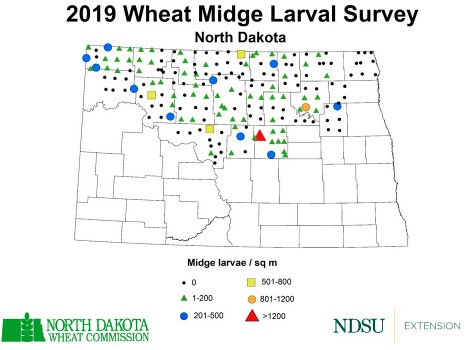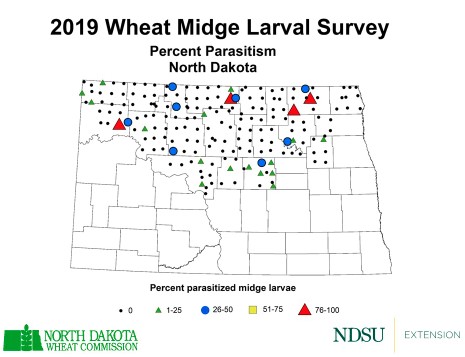Soil samples in North Dakota indicate increasing levels of overwintering wheat midge larvae (cocoons) for the 2020 season, says Janet Knodel, North Dakota State University Extension entomologist.
A total of 1,900 soil samples were collected from 20 counties in the fall of 2019 to estimate the statewide risk for wheat midge in the 2020 field season. The distribution of wheat midge is based on unparasitized cocoons found in the soil samples.
“About 1% of the soil samples had very high population densities of wheat midge (greater than 800 midge larvae per square meter) this past year,” Knodel says. “The hot spots were located in west central Wells County and southwestern Ramsey County.”
Another 2% was at a high-risk level (501 to 800 midge larvae per square meter) in northeastern Bottineau County, central Mountrail County and northeastern McLean County.
“These populations are high and indicate that an insecticide will probably be needed to reduce potential yield loss from wheat midge, assuming wheat is in the susceptible growth stages during midge emergence and midge populations are at economic threshold levels during field scouting,” Knodel notes.
Scouting for wheat midge adults during emergence is a good integrated pest management, especially if wheat fields are in the susceptible crop stage, heading to early flowering (less than 50% flowering). Scouting for the orange adult flies is conducted at night when temperatures are greater than 59 F and the winds are less than 6 mph.
“Use a flashlight and slowly scan the heads of wheat plants for wheat midge adults, counting the number of flies per head,” Knodel says.
The economic thresholds for wheat midge are: one or more midge observed for every four or five heads on hard red spring wheat, or one or more midge observed for every seven or eight heads on durum wheat.
The moderate risk level (201 to 500 midge larvae per square meter) also was observed in 5% of the samples. Moderate risk areas were scattered in eight counties throughout the state, including the northeastern area (Nelson County), the central area (Sheridan and Wells counties), the north-central area (McHenry and Rolette counties), and the northwestern area (Divide, Mountrail, Williams counties).
“These population levels are considered non-economic for wheat midge,” Knodel says.
Thirty-four percent of the soil samples were at low risk, but scouting for wheat midge always is a good idea. The majority of the soil samples, 58%, had zero wheat midge cocoons, compared with the record low of 84% in 2018.
Knodel adds, “This dramatic increase in wheat midge populations is probably due to the rain in 2019. Plotting out the total rainfall from May through September and total number of wheat midge cocoons for the past eight years showed a strong correlation between precipitation and wheat midge populations.”
Larvae are susceptible to dryness and require rain to emerge from the soil in late June through mid-July, and to drop out of the wheat heads and dig into the soil to overwinter as cocoons.
Knodel recommends that producers use the wheat midge degree-day model to predict the emergence of wheat midge and to determine when to scout, and if their wheat crop is at risk.
Producers can access the wheat midge degree-day model on the North Dakota Agricultural Weather Network (NDAWN) website at https://ndawn.ndsu.nodak.edu/wheat-growing-degree-days.html.
Select your nearest NDAWN station and enter your wheat planting date. The output indicates the expected growth stage of the wheat and whether the crop is susceptible to midge infestation, as well as the timing of wheat midge emergence.


Knodel says, “The good news for 2019 is that the beneficial parasitic wasp, which naturally controls wheat midge eggs and larvae, increased to 15% of wheat midge cocoons parasitized, compared with only 9% in 2018. The average parasitism rate was also higher: 36% in 2019, compared with less than a 5% parasitism rate for the last four years (2015 to 2018). The highest parasitism rates were found in Bottineau, Cavalier and Williams counties.
“We need to continue to conserve parasitic wasp populations by scouting for wheat midge and spraying insecticides only when wheat midge populations are at economic threshold levels,” she adds. “Parasitic wasps fly later than wheat midge, so avoiding any late insecticide applications also will reduce the negative impacts on these ‘good’ insects. This tiny, metallic wasp does an excellent job keeping the wheat midge in check by providing free biological control of wheat midge in wheat fields."
NDSU Extension agents collected the soil samples. The North Dakota Wheat Commission supports the wheat midge survey.
Source : ndsu.edu